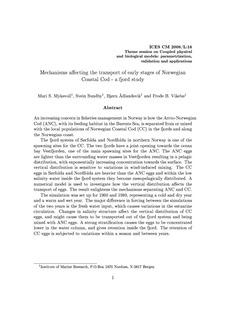Mechanisms a ecting the transport of early stages of Norwegian Coastal Cod - a fjord study
Original version
This report is not to be quoted without prior consultation with the General Secretary.Abstract
An increasing concern in sheries management in Norway is how the Arcto-Norwegian
Cod (ANC), with its feeding habitat in the Barents Sea, is separated from or mixed
with the local populations of Norwegian Coastal Cod (CC) in the fjords and along
the Norwegian coast.
The fjord system of Sørfolda and Nordfolda in northern Norway is one of the
spawning sites for the CC. The two fjords have a joint opening towards the ocean
bay Vestfjorden, one of the main spawning sites for the ANC. The ANC eggs
are lighter than the surrounding water masses in Vestfjorden resulting in a pelagic
distribution, with exponentially increasing concentration towards the surface. The
vertical distribution is sensitive to variations in wind-induced mixing. The CC
eggs in Sørfolda and Nordfolda are heavier than the ANC eggs and within the low
salinity water inside the fjord system they become mesopelagically distributed. A
numerical model is used to investigate how the vertical distribution a ects the
transport of eggs. The result enlightens the mechanisms separating ANC and CC.
The simulation was set up for 1960 and 1989, representing a cold and dry year
and a warm and wet year. The major di erence in forcing between the simulations
of the two years is the fresh water input, which causes variations in the estuarine
circulation. Changes in salinity structure a ect the vertical distribution of CC
eggs, and might cause them to be transported out of the fjord system and being
mixed with ANC eggs. A strong strati cation causes the eggs to be concentrated
lower in the water column, and gives retention inside the fjord. The retention of
CC eggs is subjected to variations within a season and between years.
